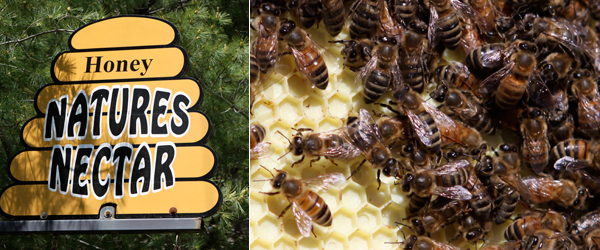
Animals as gifts are fairly common — perhaps the image of the puppy tied with a big red bow under the tree on Christmas morning has just popped into your head. But for Jim Kloek, a regular cat or dog would not do. Instead, his family decided to give him a beehive for his holiday gift 18 years ago. Since that time, Kloek has grown his beekeeping hobby into a second business.
Nature’s Nectar is located just north of Stillwater on Manning Trail. It’s run out of Kloek’s home and fosters 50 to 75 hives at any given time. Some hives are kept in the field adjacent to his backyard while other bee yards are in northern Washington County. Kloek sells his bulk and bottled honey at Fresh and Natural Foods in Hudson and Shoreview and in bulk at the River Market Co-op in Stillwater. Several bakeries, Cafe Latté, Bread Art, and The Bikery, also use his honey in their products.
At the peak of Kloek’s business, about seven years ago, he was keeping over 100 hives. But he explains that beekeeping is a tough business and requires dedication. With his full-time pipefitting job, he now focuses on beekeeping only when his schedule allows.
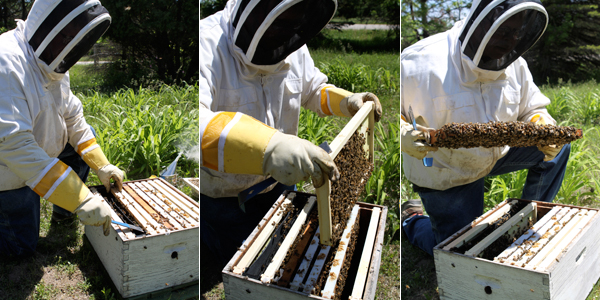
“If you keep bees, you’re going to get stung — occupational hazard,” says Kloek. But despite an allergy to bee venom that he developed seven years ago, Kloek continues to keep bees. After a course of treatment, he has now built up a tolerance and can handle a few bee stings, which is good because he says he is stung several times in a season.
Bees are classified as farm animals and can be kept in city limits (even downtown Minneapolis and St. Paul), with proper permits. Although located in a less populated area, Nature’s Nectar does have residential neighbors, but there have been no complaints thus far.
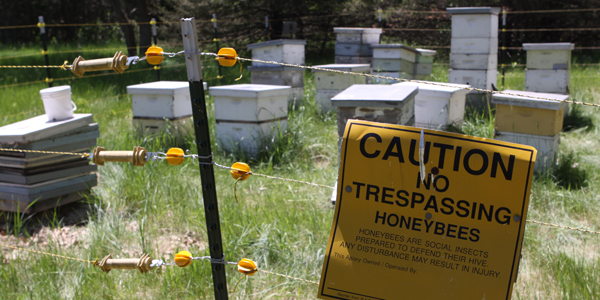
Kloek jokes about his bees being a good guard system as well as a hobby. During the last election, while his neighbors had their yard signs vandalized, he had no problems once he placed an empty hive box in his yard and posted a sign that read: “Caution: No trespassing — beehives.”
All kidding aside, Kloek explains, “You have to be a responsible beekeeper — making sure that water is available so they don’t go searching for water in places like swimming pools.”
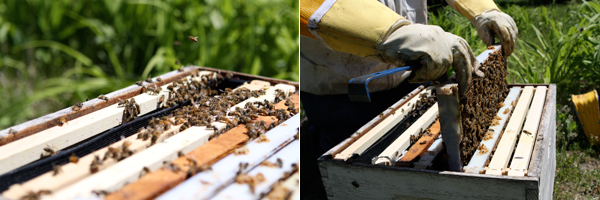
1. Obtaining Bees
The first step to starting a hive is to obtain a package of bees in the mid-April to May timeframe. Packages typically come in two or three pound boxes (around 6,000 bees) and contains a queen bee. It is recommended to start with two hives, in case one becomes weak. There are several sources for purchasing bees; Kloek buys his from California.
The bees are placed in a one-foot high box and are cared for as they grow. Kloek says a new colony expands to about 30,000 bees by mid-June and to about 50,000 bees by the first of July. As the hive grows, more boxes are added to provide more room for the bees themselves and their honey.
You may also obtain bees by catching a swarm, but it’s best to leave this to the professionals. Kloek is often called to help remove swarms for others, which he then adds to his farm.
2. Providing for the Bees’ Needs
Bees have three basic needs: water, pollen, and nectar.
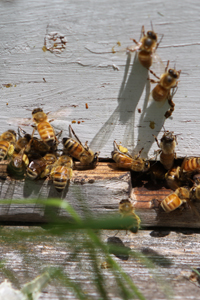
Water – Water is used for temperature and humidity control, as well as in feeding developing bees.
Pollen – Bees gather pollen from flowers and trees as a protein energy source. They bring the powdery yellow / orange tufts back to the hive attached to their hind legs. Pictured to the left are several bees arriving back to the hive with pollen attached at their hind legs.
Nectar – Nectar is also gathered by bees as an energy source and, ultimately, is processed by the hive bees into the sticky sweet food we recognize as honey. The watery substance is gathered from nectar-producing flowers and stored in the bee’s second stomach (designed solely for storing nectar). In the early months when nectar is not available, beekeepers add a simple syrup solution to the hive to ensure that this need is being met.
Once the bee has gathered a nectar load approximately equal to its weight, it returns to the hive where it transfers the nectar to a hive bee to further process, which is detailed further below.
Given that there are thousands of bees gathering honey for a hive, how could they know what source to gather it from? Bees communicate to one another about the location of pollen and nectar though a dance that they perform. Depending on its waggling and circling, the bee communicates to the others the exact location (distance and direction) of where a good source of pollen or nectar can be found.
The final taste of the honey (minty, buttery, etc.) is determined by the source(s) of the nectar gathered by a particular hive. According to Kloek, there are over 300 flavors of honey throughout the United States. And while there are many varieties available in Minnesota, the most common is clover honey. Much of the honey on the market is a combination of several nectars from several hives, but there are several suppliers that produce single-sourced honey (from one nectar source and usually one hive) including Ames Farm in Delano, MN. The Golden Fig in St. Paul carries a sampler variety pack of Ames’ single-source honeys of different flavors.
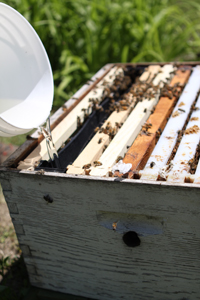
3. The “Making” of Honey
As long as the bees’ needs are being met, the bees do all the work in “making” the honey. This deserves quotation marks, as it really is less making than it is processing nectar into a product identifiable as honey.
Once nectar is delivered to the hive by the worker bees, the water is removed and deposited on the wall of the hive. The bees then use their wings to fan the hive (hence the flurry of buzzing inside) until the water evaporates. With the removal of the water the nectar thickens and cools until it decreases to less than 18.6% water, which qualifies it as Grade A honey. Once the honey is ripe, the bees cap it with wax.
At this point, extraction begins.
4. Extraction
Stay tuned for the write up and photographs from our upcoming extraction lesson from Kloek of Nature’s Nectar.
For more information on beekeeping:
The Bee Lab at The University of Minnesota — classes and other resources
Minnesota Hobby Beekeepers Association
Honey Locator — Minnesota listing
Nature’s Nectar Beekeeping Blog — What Should I Be Doing With My Bees This Month?
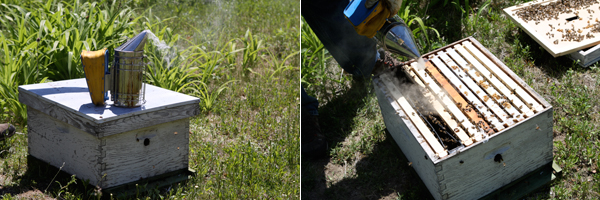

We got the honey for our Biscotti beer from Nature’s Nectar. Gotta love honey.
I have a honey bee hive in my foundation. Would you like to remove them and try and save them or know of anybody who does this sort of work?
I have just come across your site and really enjoyed reading it. I have bookmarked it. Any recommendations on further reading?
Jim I just talked to you on buying bees. Just checking to make sure you got my E-mail address correct
thank you
Tony Koran
Dear Jim Kloek, my neighbor has bees in her tree next to her house. She would like them moved; doesn’t want the tree cut down. We don’t think they are honey bees. Is there anyone out this way who could move them? Location Winsted (zip 55395) – 1 hour west of Mpls. 20 miles east of Hutchinson, MN.
Thanks, Linda Dornfeld
email or tel. 320-485-4239